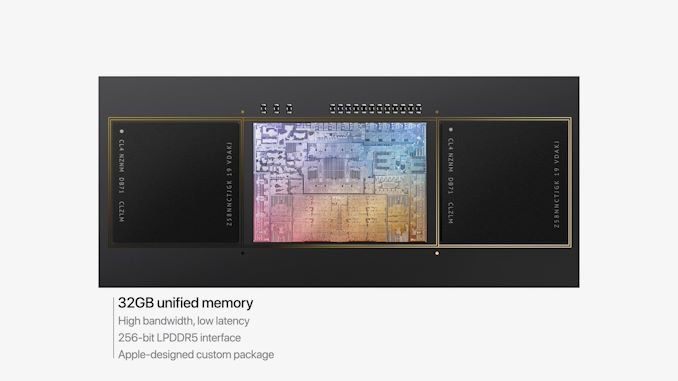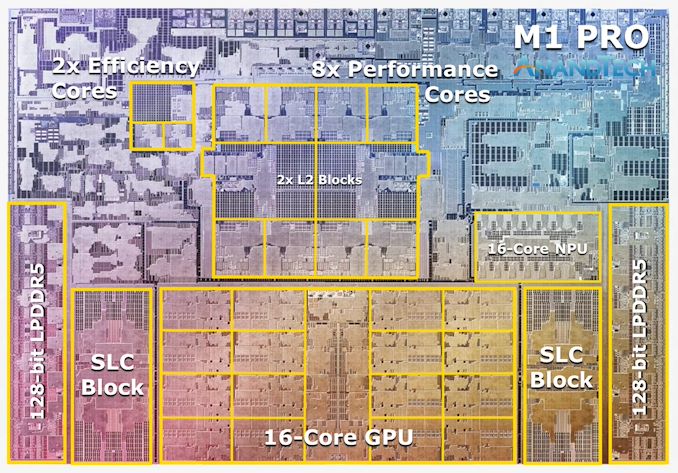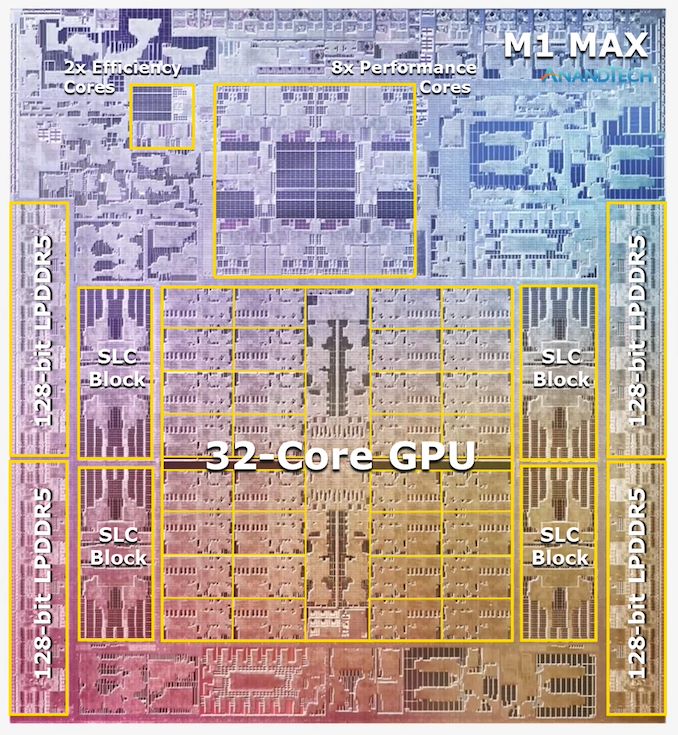Apple's M1 Pro, M1 Max SoCs Investigated: New Performance and Efficiency Heights
by Andrei Frumusanu on October 25, 2021 9:00 AM EST- Posted in
- Laptops
- Apple
- MacBook
- Apple M1 Pro
- Apple M1 Max

Last week, Apple had unveiled their new generation MacBook Pro laptop series, a new range of flagship devices that bring with them significant updates to the company’s professional and power-user oriented user-base. The new devices particularly differentiate themselves in that they’re now powered by two new additional entries in Apple’s own silicon line-up, the M1 Pro and the M1 Max. We’ve covered the initial reveal in last week’s overview article of the two new chips, and today we’re getting the first glimpses of the performance we’re expected to see off the new silicon.
The M1 Pro: 10-core CPU, 16-core GPU, 33.7bn Transistors
Starting off with the M1 Pro, the smaller sibling of the two, the design appears to be a new implementation of the first generation M1 chip, but this time designed from the ground up to scale up larger and to more performance. The M1 Pro in our view is the more interesting of the two designs, as it offers mostly everything that power users will deem generationally important in terms of upgrades.
At the heart of the SoC we find a new 10-core CPU setup, in a 8+2 configuration, with there being 8 performance Firestorm cores and 2 efficiency Icestorm cores. We had indicated in our initial coverage that it appears that Apple’s new M1 Pro and Max chips is using a similar, if not the same generation CPU IP as on the M1, rather than updating things to the newer generation cores that are being used in the A15. We seemingly can confirm this, as we’re seeing no apparent changes in the cores compared to what we’ve discovered on the M1 chips.
The CPU cores clock up to 3228MHz peak, however vary in frequency depending on how many cores are active within a cluster, clocking down to 3132 at 2, and 3036 MHz at 3 and 4 cores active. I say “per cluster”, because the 8 performance cores in the M1 Pro and M1 Max are indeed consisting of two 4-core clusters, both with their own 12MB L2 caches, and each being able to clock their CPUs independently from each other, so it’s actually possible to have four active cores in one cluster at 3036MHz and one active core in the other cluster running at 3.23GHz.
The two E-cores in the system clock at up to 2064MHz, and as opposed to the M1, there’s only two of them this time around, however, Apple still gives them their full 4MB of L2 cache, same as on the M1 and A-derivative chips.
One large feature of both chips is their much-increased memory bandwidth and interfaces – the M1 Pro features 256-bit LPDDR5 memory at 6400MT/s speeds, corresponding to 204GB/s bandwidth. This is significantly higher than the M1 at 68GB/s, and also generally higher than competitor laptop platforms which still rely on 128-bit interfaces.
We’ve been able to identify the “SLC”, or system level cache as we call it, to be falling in at 24MB for the M1 Pro, and 48MB on the M1 Max, a bit smaller than what we initially speculated, but makes sense given the SRAM die area – representing a 50% increase over the per-block SLC on the M1.
The M1 Max: A 32-Core GPU Monstrosity at 57bn Transistors
Above the M1 Pro we have Apple’s second new M1 chip, the M1 Max. The M1 Max is essentially identical to the M1 Pro in terms of architecture and in many of its functional blocks – but what sets the Max apart is that Apple has equipped it with much larger GPU and media encode/decode complexes. Overall, Apple has doubled the number of GPU cores and media blocks, giving the M1 Max virtually twice the GPU and media performance.
The GPU and memory interfaces of the chip are by far the most differentiated aspects of the chip, instead of a 16-core GPU, Apple doubles things up to a 32-core unit. On the M1 Max which we tested for today, the GPU is running at up to 1296MHz - quite fast for what we consider mobile IP, but still significantly slower than what we’ve seen from the conventional PC and console space where GPUs now can run up to around 2.5GHz.
Apple also doubles up on the memory interfaces, using a whopping 512-bit wide LPDDR5 memory subsystem – unheard of in an SoC and even rare amongst historical discrete GPU designs. This gives the chip a massive 408GB/s of bandwidth – how this bandwidth is accessible to the various IP blocks on the chip is one of the things we’ll be investigating today.
The memory controller caches are at 48MB in this chip, allowing for theoretically amplified memory bandwidth for various SoC blocks as well as reducing off-chip DRAM traffic, thus also reducing power and energy usage of the chip.
Apple’s die shot of the M1 Max was a bit weird initially in that we weren’t sure if it actually represents physical reality – especially on the bottom part of the chip we had noted that there appears to be a doubled up NPU – something Apple doesn’t officially disclose. A doubled up media engine makes sense as that’s part of the features of the chip, however until we can get a third-party die shot to confirm that this is indeed how the chip looks like, we’ll refrain from speculating further in this regard.














493 Comments
View All Comments
Spunjji - Tuesday, October 26, 2021 - link
It's a combination of 2 of the responses you got - advanced packaging (having memory close to the SoC) and using the most advanced manufacturing process to spend a *lot* of transistors.On the CPU side, Zen 4 on TSMC N5 is likely to approach the power and performance levels of M1 Pro, albeit with a higher idle power and (probably) higher peak performance if efficiency is sacrificed entirely.
Ppietra - Tuesday, October 26, 2021 - link
more advanced node is a very small reason in order to explain it.AMD is supposedly already using the 7nm+ node and difference between this and 5nm is not that big... at most a 10% improvement in perf/W considering TSMC info.
As for the memory packaging advantage, as far as I understand that is an extra that is not included in these values (except in the Wall Power consumption), they are only measuring the processor package power. Even if you were talking about the memory controller the difference would only be 1-2W, hardly enough to explain the total difference in power consumption. And this is before actually looking at performance per Watt.
BushLin - Tuesday, October 26, 2021 - link
Combination microwave ovens are a thing btw, most efficient way to roast turkey if it fits inside. Just sayin'https://www.panasonic.com/uk/consumer/home-applian...
BushLin - Tuesday, October 26, 2021 - link
Was relevant to a comment above, now just looks weirdYouyou122 - Tuesday, October 26, 2021 - link
Is M1 max with 32 GB ram can reach to 400 GB bandwitch speed ? Or it’s just in 64 GB ram version?Spunjji - Tuesday, October 26, 2021 - link
AFAIK the 32GB version retains the full memory bandwidth.Spunjji - Tuesday, October 26, 2021 - link
It seems Apple's M1 chips are destined to produce flame-wars in the comments...I'm genuinely impressed by these designs. The CPU side of the SoC is extremely capable and, even accounting for node differences, shows a very interesting perf/watt over Intel and (to a lesser extent) AMD.
The GPU side, on the other hand, is less relevant to my interests. They've clearly designed an extremely capable arithmetic machine that's great for video filters. Unfortunately, between the near-non-existence of ARM binary games on Mac and the painful results of binary translation, it's apparently still not possible to game well on macOS. That perf/watt is still pretty promising, but they have less of an advantage over AMD/Nvidia here than on the CPU side. I suspect the transition to 5nm-class nodes will see AMD and Nvidia catching up again.
Farfolomew - Tuesday, October 26, 2021 - link
I was a bit disheartened as well with the M1's game performance. It kind of stinks that you have this incredible new SoC, that is 2-3x more efficient than anything before it, hamstrung by it's need to run binary translation. I suppose that was always going to be the case with Apple making the switch, but it's such a tease to see what a chip design could be truly capable given near infinite R&D $ and limitless design constraints.I'll be sticking to x86 for now. I hope the players in this camp step up their game and copy Apple in this new SoC design (or AMD produces a mainstream PC part that mimic's their console SoCs)
Tigran - Tuesday, October 26, 2021 - link
Why there are two different results of MSI GE76 Raider in GFXBench 5.0 Aztec Ruins High off-screen: 266 fps (page 'Power Behaviour') and 315 fps (page 'GPU Performance')?vladx - Tuesday, October 26, 2021 - link
Because Andrei is a terrible reviewer